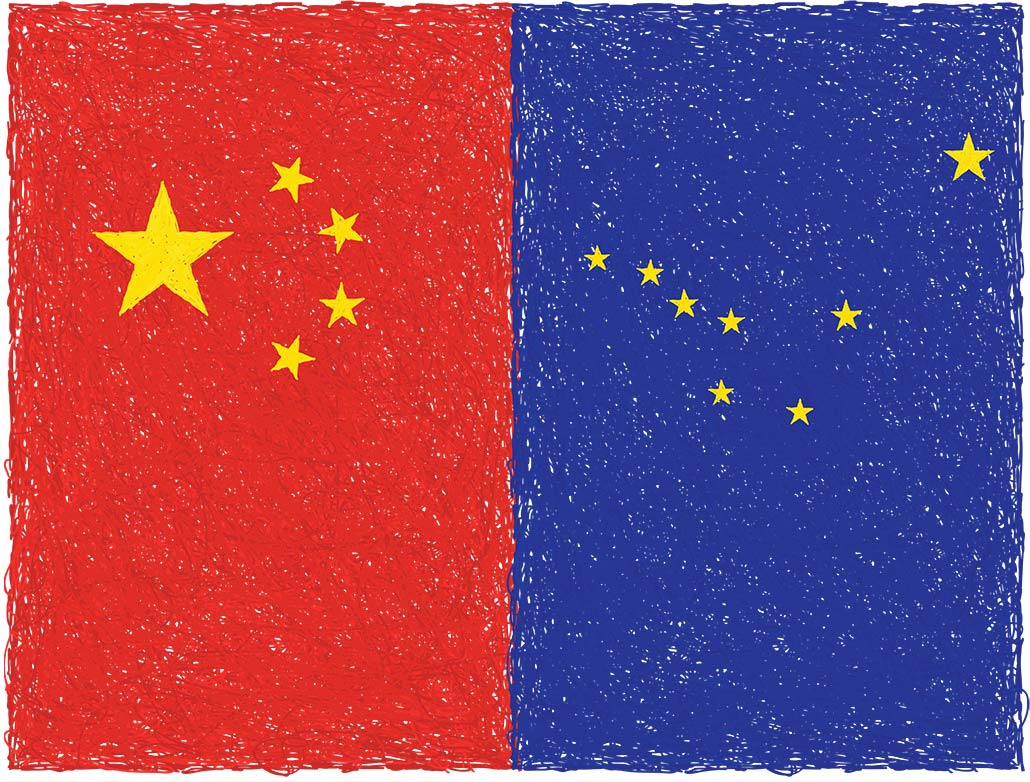hina is the world’s largest importer of natural resource commodities, and Alaska is a major American producer and exporter of many of those commodities, so the growing commercial ties between the Middle Kingdom and the Great Land make for a natural, mutually beneficial trading partnership. And, indeed, the dramatic growth of China as an economic powerhouse has fueled continued expansion of Alaska’s international trade economy and has been the headline story for the state’s export community for the past two decades.
The rise of China as a global economic force to be reckoned with began with the economic reforms commenced in the late 1970s. From then, until as recently as 2015, the country averaged 10 percent annual GDP growth rates. China’s economy is now ranked the second largest in the world, behind the United States and ahead of Japan. In recent years, as the economy has grown and matured, growth rates have slowed but are still strong. Currently, the country’s GDP growth rate sits at about 6.5 percent, according to the World Bank.

Seafood is the predominate export commodity from Alaska to China, accounting for 57 percent of the total. Minerals and ores is the second largest category at 27 percent. The two other notable export categories are energy at 7 percent and forest products at 6 percent.
Another example is Kensington Mine. Just prior to the pouring of first gold at the new mine, the American company that operates the mine, Coeur d’Alene Mines Corporation, announced it had reached a landmark agreement whereby China National Gold Group, a state-owned Chinese mining company, would purchase approximately 50 percent of the gold ores produced at Kensington.
While neither of these examples qualify as direct investment, with one a purchase of equity in a Canadian company and the other being a long term purchase agreement, it does, however, clearly demonstrate China’s awareness and interest in participating in Alaska resource development projects.
One such project that potentially involves direct Chinese investment is the proposed natural gas export project, known as Alaska LNG. The project would transport gas south from Alaska’s North Slope via an 800-mile pipeline. At the tidewater port of Nikiski, the natural gas would be cooled and compressed at a liquefaction plant to convert it into liquid natural gas (LNG) for shipment via specially-built tankers to customers in Asia. The current project cost estimate is $43 billion.
In November 2017, the State of Alaska and the Alaska Gasline Development Corporation (AGDC) entered into a Joint Development Agreement with a consortium of three state-owned Chinese entities. The non-binding agreement provides a framework for negotiation regarding Chinese investment participation in the project as well as the purchase of some portion of the LNG produced. The three Chinese partners to the agreement are well-known, major players in global finance and energy: Bank of China is the world’s fifth largest bank; China Petrochemical (Sinopec) is ranked as the world’s fifth largest oil and gas company; and China Investment Corporation, a Chinese sovereign wealth fund with more than $900 billion in assets under management, is the third largest fund in the world.
The agreement between AGDC and the Chinese partners was re-affirmed in October 2018, allowing negotiations to continue. China is currently the world’s third largest buyer of LNG, trailing Japan and Korea, but is widely expected to rise to the number one position in a few years.
Beside FedEx, UPS, and several other major American all-cargo airlines, there are a number of China and Hong Kong-based carriers that operate flights between China and US cities via Anchorage, including Air China, China Cargo Airlines, China Southern Airlines, Yangtze River Express, and Cathay Pacific.
On the passenger side of the business, Alaska does not currently enjoy direct service to China, but there are talks underway with several Chinese carriers regarding the potential of direct passenger flights between Harbin and Anchorage. Harbin is the capitol city of Heilongjiang Province in northern China.
In the realm of higher education, the University of Alaska Anchorage is set to host a Confucius Institute, a program sponsored by the Chinese government to expand the use of the Chinese language and the understanding of Chinese culture. The Institute at UAA was established in 2008. In addition to teaching language classes, the Institute also hosts a number of cultural events each year for students and the community at large.
World Trade Center Anchorage (WTC-ANC) has been actively building on the Alaska-China relationship for more than fifteen years. In that time, WTC-ANC has led trade missions to China, introducing Alaskan business people and government leaders to their counterparts in China. Twelve years ago WTC-ANC launched the Alaska-China Business Conference, a unique, annual event that brings together business and government leaders from Alaska and China to discuss the state of the relationship and opportunities for expanding commercial ties in the areas of trade, commerce, and investment. In addition, WTC-ANC hosts in-bound missions from China and visits from government and business dignitaries. These visits have included China’s ambassador to the United States, consul generals, and CEOs from major Chinese corporations.
Looking forward, while there may be friction from time to time at the nation-to-nation level, Alaska can play a positive role in bringing the two countries closer with projects and partnerships that are win-win for both sides. The Alaska-China relationship is strong and growing and is a natural partnership based on mutual benefit. ![]()